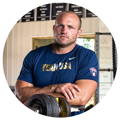Butt Stuff
Butt Stuff: Glute Centric Fitness
Day in and day out of the gym, you are working towards something. Striving for a sleek aesthetic, improving performance, chasing efficiency in functional movement and even working simply on preventing injury.
There is one thing all of these have in common: the importance of your glute muscles in each and every one of these endeavors. Your glutes play a massive role in every one of these goals and how you approach your training can help mold the outcome of your goals.
Glute centric fitness, booty gains, a juicy booty, butt stuff: call it what you want, we are going to unpack what this all means and how to capitalize on one of our favorite muscles to train.

What is Glute Centric Fitness
Just as you would think, Glute Centric Fitness focuses on directly training your glutes. From the most basic compound movements like squats and deadlifts, to the more unique movements like quadruped banded kick backs and other isolation exercises, Glute Centric Fitness focuses on proper form, activation and muscle engagement to maximize not only the effectiveness of the workout but also see and feel the improvements of the booty.
Whether you are team lower body or team upper body, we all know that strong, powerful glutes are an important piece to any training protocol. Understanding how to properly train your glutes, each of the muscles involved, and how to make sure you are training in a well-rounded manner (no pun intended) is important when you approach a potentially glute focused training cycle.

Benefits of Glute Training
As you will see, strong glutes are imperative to a strong body. Similar to core work, when you have strong glutes, you will find gains and success in the gym and sport comes just a bit easier.
Strong glutes allow you to better stabilize your pelvis and maintain proper alignment of the spine. This contributes to dynamic trunk control, which we love, and is essential to prevent injuries and lower back pain.
Weak glutes can often lead to you compensating in some other area and then further exasperating imbalances in your body. This leads to injury that could easily be avoided had your glutes been trained in a more well-rounded fashion.
Also take into consideration how many times a day you sit down, stand up, bend over to pick something up or even simply notice your posture. Your glutes are the key component in being able to do each and every one of those simple movements. It's easy to take for granted our glutes because something like a sit to stand is so basic. But translate that sit to stand into something like a box squat. Now all of a sudden, a well-trained and well-rounded rear is inherently more important to improve.
Glute Anatomy

When we talk about booty gains, we refer to the glutes as one muscle. But in fact, the glutes are composed of 3 different muscles: gluteus maximus, gluteus minimus and gluteus medius. The three muscles work together to support movements of the hip and pelvis. Together they provide stability, power and balance in both life and sport. The three muscles all originate from the ilium and sacrum and insert on the femur. So, while there are things in common with these three different muscles, they each have their own purpose.
Gluteus Maximus
This is the largest of the three muscles. Your glute max is also your largest muscle in your posterior chain. It is the one that makes up the bulk of the shape of your backside and is primarily responsible for hip extension. A large, lean butt is not only oftentimes aesthetically pleasing but also has a functional purpose as well. This muscle aids in keeping you upright as a human but it also helps in climbing stairs, running and squatting. You name it and the gluteus maximus likely plays a role in what you are trying to accomplish. Want to see a strong, powerful runner, ball player or athlete? They are often easily spotted because they have a round rump that is hard to go unnoticed.
Gluteus Medius
Located on the outermost part of your backside, the glute medius is mostly responsible for moving your leg away from your body. This part of your glute also plays a large role in stabilizing the pelvis when you run, walk or even do single leg exercises that require you to maintain a neutral hip position.
Gluteus Minimus
Being the smallest of the three parts of your glute, the gluteus minimus acts similarly to the gluteus medius in that it primarily aids in hip abduction. This specific muscle also helps with internal rotation of the thigh and stabilizing the hip joint.
Why does it matter that you know the difference between each individual glute muscle? This is because we want our training to be well rounded. You need to make sure you are not simply exercising the most obvious and most common muscle to train (gluteus maximus) over and over again. To be a well-rounded athlete and have a well-rounded physique, training both larger and smaller stabilizer muscles can help you level up your gains.
Ways to Train Glutes
Again, since we want our training to be well rounded, when considering different ways to train, you need to make sure your programming has variety. Don't mistake that for randomness.
Random training is not the same as variety.
Random training has no structure, no planning and no progressive overload. On the other hand, variety is when your training is intentionally planned, thought out and you see progressive overload over the course of the training cycle. If you struggle with getting a well-rounded, thought-out program that leaves you constantly making progress in the gym, Peak Strength can help you take the guesswork out of what you are doing and it's likely the answer to most of your programming snafus.
Let's take a closer look at five different ways to add variety to any well thought out program.
Weight Training
This is the most common and will likely be the most utilized way to train your glutes. Resistance training with weights is necessary for muscle growth and development. Leaning on compound movements like squats, deadlifts and hip thrusts are keyways to train your glutes. But don’t underestimate the power of these movements in the single leg form- each a single leg squat, deadlift and hip thrust or similarly a glute bridge. Versatility in how you approach weighted compound movements can be a great way to add variety. Also, having variety in how you incorporate your basic compound movements ensures you are targeting more than just the gluteus maximus over the course of a training cycle.

Body Weight Exercises
Body weight exercises can be a great addition to butt focused training. Whether it's because you are short on time, equipment or are simply looking to add the key piece of variety, training with bodyweight can add a level of challenge that traditional weighted resistance training can’t. For example, glute bridges, lunges, and even box step ups are great ways to target your glutes- and they can be done in many different planes. Moving laterally, adding tempo, incorporating a dynamic component and even manipulating your work to rest ratios allows for added challenges that traditional resistance training can't quite match.
Banded Training
A twist on resistance training is one that incorporates bands. Again, to reiterate that weight training is necessary for strength improvements, banded training can be a way to add resistance and a novel stimulus to training each of the three separate glute muscles.
Movements like banded squats, banded lateral walks, banded adduction and abduction exercises are all novel ways to train your glutes in a well rounded manner. Incorporating banded movements like these are highly beneficial for many reasons. First, where you specifically place a band can change the specific part of the glute you are trying to train. Looking to increase activation of your glute medius? Placing a band just above the knee and performing lateral walks does just that and in turn helps with hip stability and alignment. Banded resistance training also provides joint friendly resistance and can be great for improving muscular endurance.
Don’t believe me? Try to place a small band just above your knees and perform a set of 20 squats, slow and controlled, all while constantly ensuring you are not allowing your knees to collapse in. Now, not only are you focusing on proper form and execution of the squat but now the added component of ensuring your knees track over your toes the entire time is incorporating the glute stabilizer muscles that are important in training as well.
Plyometric Exercises
Plyometric training can be beneficial in glute centric fitness for many reasons. Things like jump squats, jumping lunges, box jumps, and any other type of hop or jump are beneficial for sport, physique and dare I say functional life training.
More specifically, plyometric training requires your glutes to have rapid muscle contractions and activates your fast twitch muscle fibers. Ultimately this translates to increased power output and enhances your glute's ability to generate force quickly and efficiently. Big wins.
Also worth noting that plyometric exercises often require dynamic stability and control, especially around the hip joint. This further increases the demand on the individual glute muscles and shows how beneficial it can be to add variety to your training.
Functional Training
We would be remiss if we didn't touch on functional training and how these types of movements can be beneficial to overall glute gains.
More specifically, hill sprints, sled work, and even stair climbing can be beneficial to add to your training. Hill sprints require powerful hip extension to move your body uphill, and that directly activates and strengthens the gluteus maximus. Running uphill also challenges balance and coordination which requires the glutes to keep proper posture and stabilize the pelvis.
Sled work is an underrated and underutilized way to train your glutes. Sled pushing involves intense activation of the glutes, especially the gluteus maximus and medius, to generate force against the resistance. The versatility of sled work allows you to train the muscles from different angles and ranges and is a low impact option that offers high intensity work to be done.
Range of Motion
Now that you have a clear idea of the different modalities you can use to train your glutes, let’s briefly spend time talking about how training in different planes and ranges of motion is beneficial in training your glutes.
Your glutes can be targeted through each plane- front to back, side to side and rotational. Things like squats and deadlifts, side lunges and banded walks as well as hip rotations all offer a unique way to target your glutes. Each of these planes requires your glutes to be trained through hip extension/flexion, knee extension/flexion, abduction/adduction and even a combination of the sort are important in well-rounded training- and ultimately a well-rounded, powerful rear.
Who Benefits from Glute Centric Fitness
Everyone. Period. There is not one person, one athlete or one human who would not benefit from training their glutes properly. Because of the role your glutes play in sport and in life, incorporating glute centric training in your regimen would benefit each and every single person reading this.
One common complaint from newer gym goers is trouble “finding their glutes.” A few tips on how to ensure your glute training is in fact training your glutes and not allowing your quad dominant body to take over.
- Sensory reminder. Can you touch your cheeks as you are performing a movement, as a physical reminder of what you are training. Glute bridges or lunges for a warmup? Poke your glutes on the squeeze and the tactile feedback can help you ensure you are engaging the proper muscles.
- Mind muscle connection. Are you thinking about what you are doing or simply going through the motions? Keep focused on the movement in question and pay attention to what muscles you are trying to engage on the working portion of a lift.
- Slow down. Slowing down and making the movement easier through less weight can sometimes be the necessary change to target and physically feel the proper muscles working.
- Warm up and activation exercises. Making sure your body, and the muscles you want to target, are primed and ready to go can be helpful. Rather than loading the bar with 2 warm up sets then getting to your working sets of squats, spending some time with a proper warm up and muscle activation can be helpful.

In Summary
Being strong, powerful and functional requires strong glutes. Strong glutes require variety in training, well rounded and planned programming and dare we say a bit of creativity to make sure you are constantly pushing the boundaries and seeking progress. If you want to continue to seek out being the strongest, most powerful, and most athletic version of yourself, keep training your glutes with intention and purpose.


Gaylemarie Kayes
Gaylemarie, but just call her GM, is a seasoned fitness and nutrition professional with nearly two decades of experience in the industry. With a diverse clientele ranging from ultra runners to high-level competitors, gm brings a wealth of knowledge and expertise. As a former high-level athlete in running, CrossFit and Olympic lifting to now, a busy yet active mother, she understands the challenges of balancing fitness and goal getting with a hectic lifestyle. Gm's approach emphasizes discipline, ownership, and hard work, tailored to honor each individual's life season for optimal health and well-being.
Blog Topics

Yo, It's Dane
Welcome to the Garage Strength Blog, where it is my goal to provide you with the experience and knowledge I've gained in the strength and conditioning world over many years of learning from both successes and failures. I train elite-level athletes in a multitude of sports from the high school to professional levels, already producing 5 Olympics and 30+ National Champions. If you want to be the next champion I train, check out my strength programs below!
Start Training With Me

Join for free educational videos EVERY WEEK on strength coaching and athletic performance

